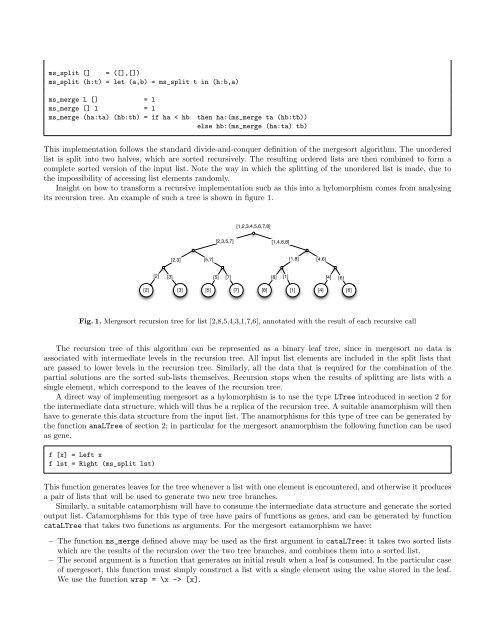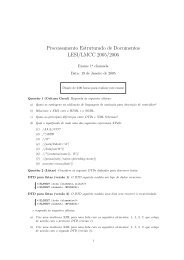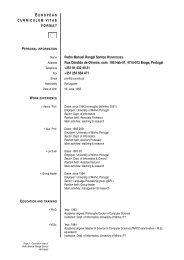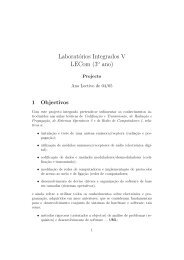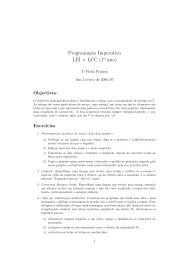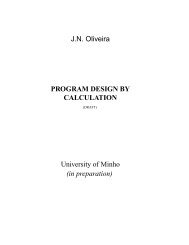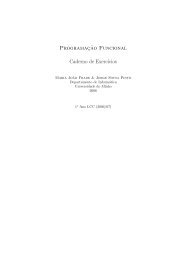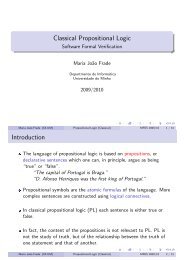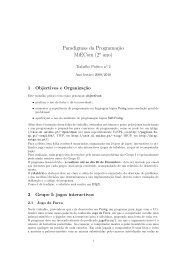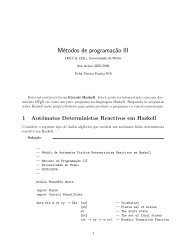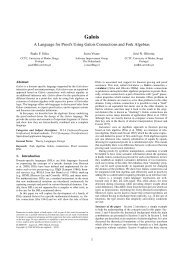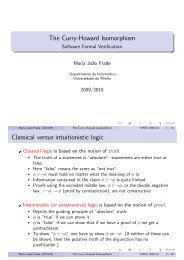Recursion Patterns and Time-analysis - Departamento de ...
Recursion Patterns and Time-analysis - Departamento de ...
Recursion Patterns and Time-analysis - Departamento de ...
You also want an ePaper? Increase the reach of your titles
YUMPU automatically turns print PDFs into web optimized ePapers that Google loves.
ms_split [] = ([],[])ms_split (h:t) = let (a,b) = ms_split t in (h:b,a)ms_merge l []= lms_merge [] l= lms_merge (ha:ta) (hb:tb) = if ha < hbthen ha:(ms_merge ta (hb:tb))else hb:(ms_merge (ha:ta) tb)This implementation follows the st<strong>and</strong>ard divi<strong>de</strong>-<strong>and</strong>-conquer <strong>de</strong>finition of the mergesort algorithm. The unor<strong>de</strong>redlist is split into two halves, which are sorted recursively. The resulting or<strong>de</strong>red lists are then combined to form acomplete sorted version of the input list. Note the way in which the splitting of the unor<strong>de</strong>red list is ma<strong>de</strong>, due tothe impossibility of accessing list elements r<strong>and</strong>omly.Insight on how to transform a recursive implementation such as this into a hylomorphism comes from analysingits recursion tree. An example of such a tree is shown in figure 1.[1,2,3,4,5,6,7,8][2,3,5,7][1,4,6,8][2,3][5,7][1,8][4,6][2] [3] [5] [7][8] [1][4] [6][2] [3] [5] [7] [8] [1] [4] [6]Fig. 1. Mergesort recursion tree for list [2,8,5,4,3,1,7,6], annotated with the result of each recursive callThe recursion tree of this algorithm can be represented as a binary leaf tree, since in mergesort no data isassociated with intermediate levels in the recursion tree. All input list elements are inclu<strong>de</strong>d in the split lists thatare passed to lower levels in the recursion tree. Similarly, all the data that is required for the combination of thepartial solutions are the sorted sub-lists themselves. <strong>Recursion</strong> stops when the results of splitting are lists with asingle element, which correspond to the leaves of the recursion tree.A direct way of implementing mergesort as a hylomorphism is to use the type LTree introduced in section 2 forthe intermediate data structure, which will thus be a replica of the recursion tree. A suitable anamorphism will thenhave to generate this data structure from the input list. The anamorphisms for this type of tree can be generated bythe function anaLTree of section 2; in particular for the mergesort anamorphism the following function can be usedas gene.f [x] = Left xf lst = Right (ms_split lst)This function generates leaves for the tree whenever a list with one element is encountered, <strong>and</strong> otherwise it producesa pair of lists that will be used to generate two new tree branches.Similarly, a suitable catamorphism will have to consume the intermediate data structure <strong>and</strong> generate the sortedoutput list. Catamorphisms for this type of tree have pairs of functions as genes, <strong>and</strong> can be generated by functioncataLTree that takes two functions as arguments. For the mergesort catamorphism we have:– The function ms_merge <strong>de</strong>fined above may be used as the first argument in cataLTree: it takes two sorted listswhich are the results of the recursion over the two tree branches, <strong>and</strong> combines them into a sorted list.– The second argument is a function that generates an initial result when a leaf is consumed. In the particular caseof mergesort, this function must simply construct a list with a single element using the value stored in the leaf.We use the function wrap = \x -> [x].


